Performance Measurement of Marketing for Private Dental Practices
VerifiedAdded on 2023/04/22
|122
|23943
|171
Thesis and Dissertation
AI Summary
This MBA dissertation examines the performance measurement of marketing in private dental practices, specifically within the UK context. The study employs both qualitative and quantitative research methods, including in-depth interviews with healthcare professionals and service users, to assess current marketing practices. The research explores the limitations of current marketing strategies and proposes the use of a balanced scorecard to evaluate performance across various perspectives, including customer, financial, business process, and learning & growth. The findings highlight the importance of tailoring marketing efforts to service user preferences and utilizing appropriate media channels. The dissertation also identifies gaps in existing strategies and provides recommendations for improvements, aiming to enhance the competitiveness and effectiveness of private dental practices. The research emphasizes the significance of performance measurement in the dental industry, offering valuable insights for academics, students, and industry professionals seeking to optimize marketing approaches and improve patient care.
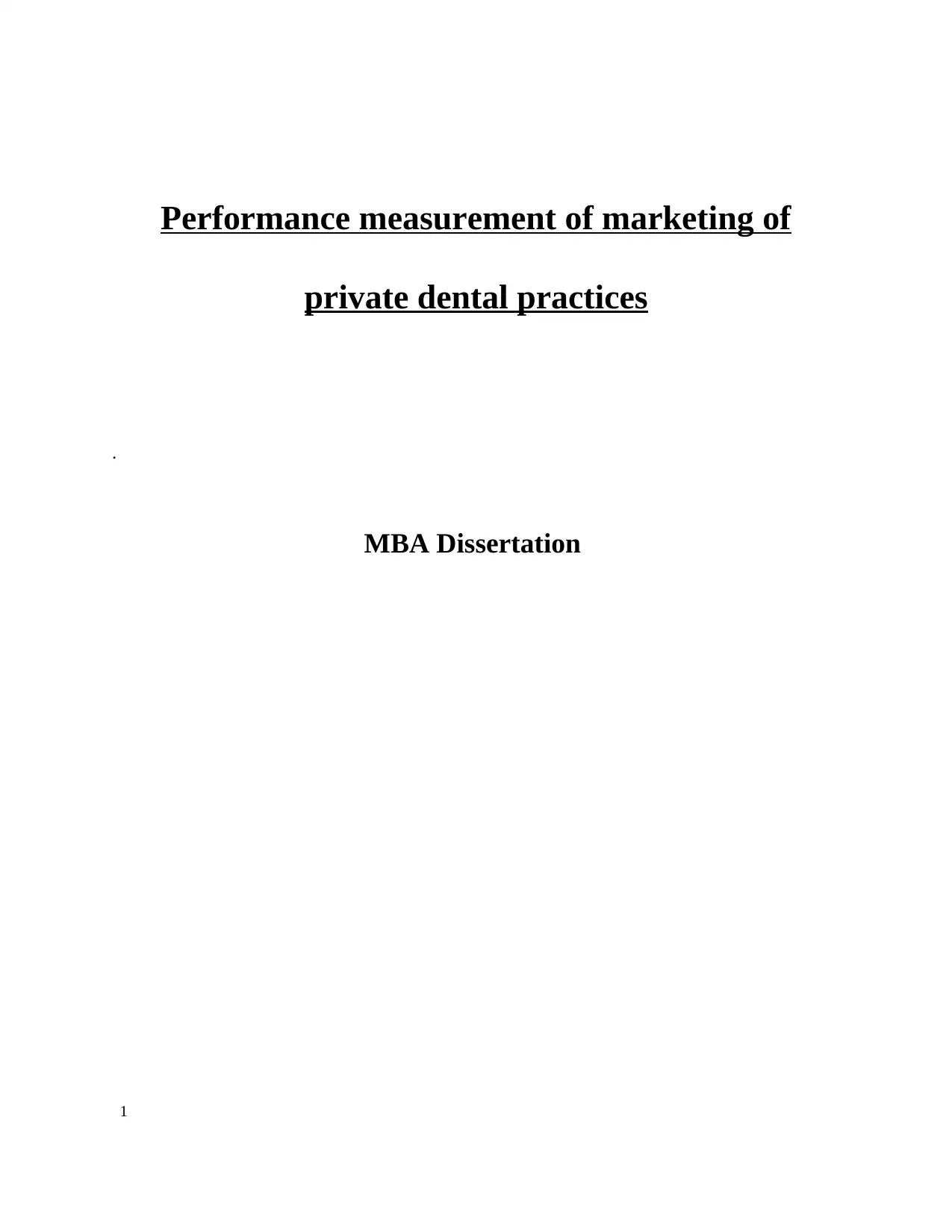
Performance measurement of marketing of
private dental practices
.
MBA Dissertation
1
private dental practices
.
MBA Dissertation
1
Paraphrase This Document
Need a fresh take? Get an instant paraphrase of this document with our AI Paraphraser
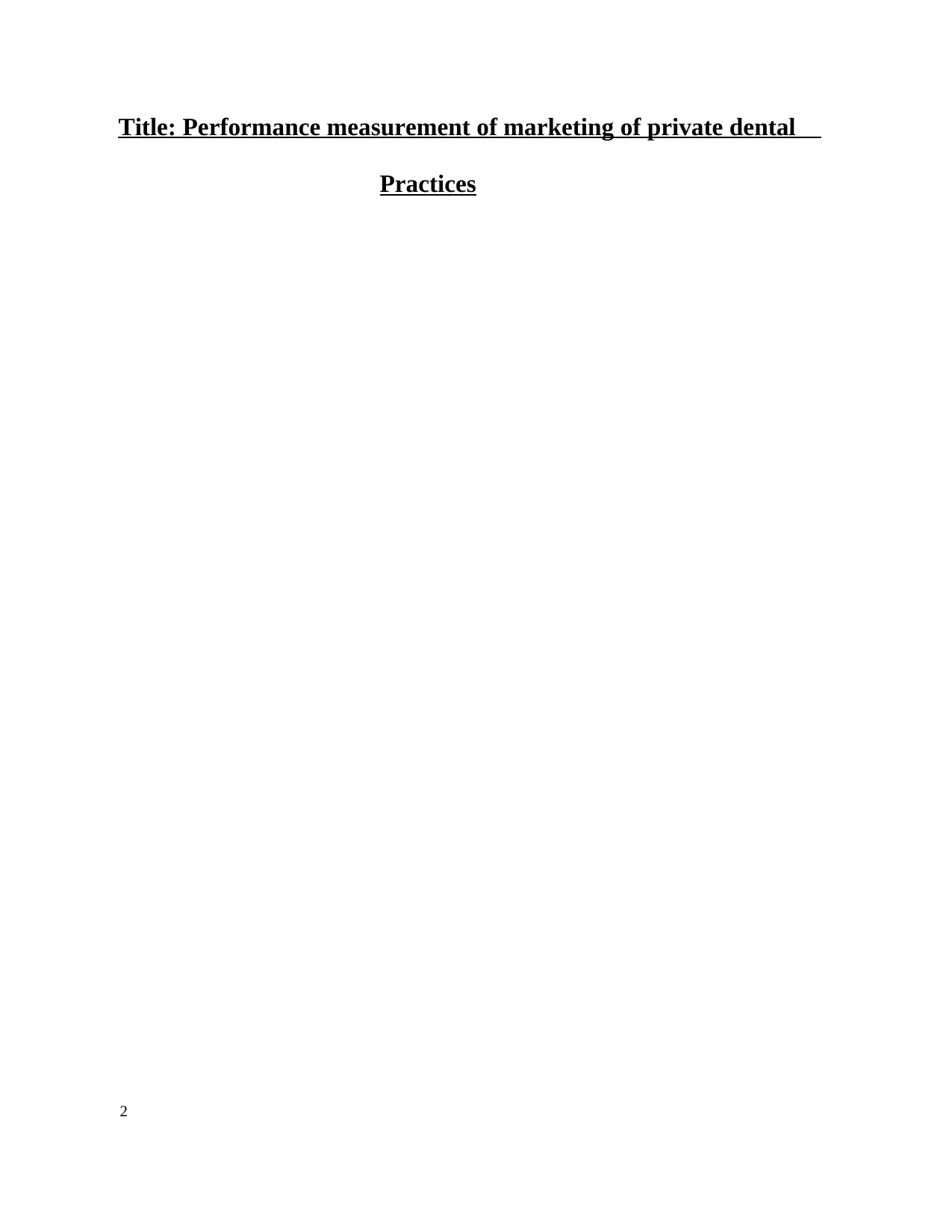
Title: Performance measurement of marketing of private dental
Practices
2
Practices
2
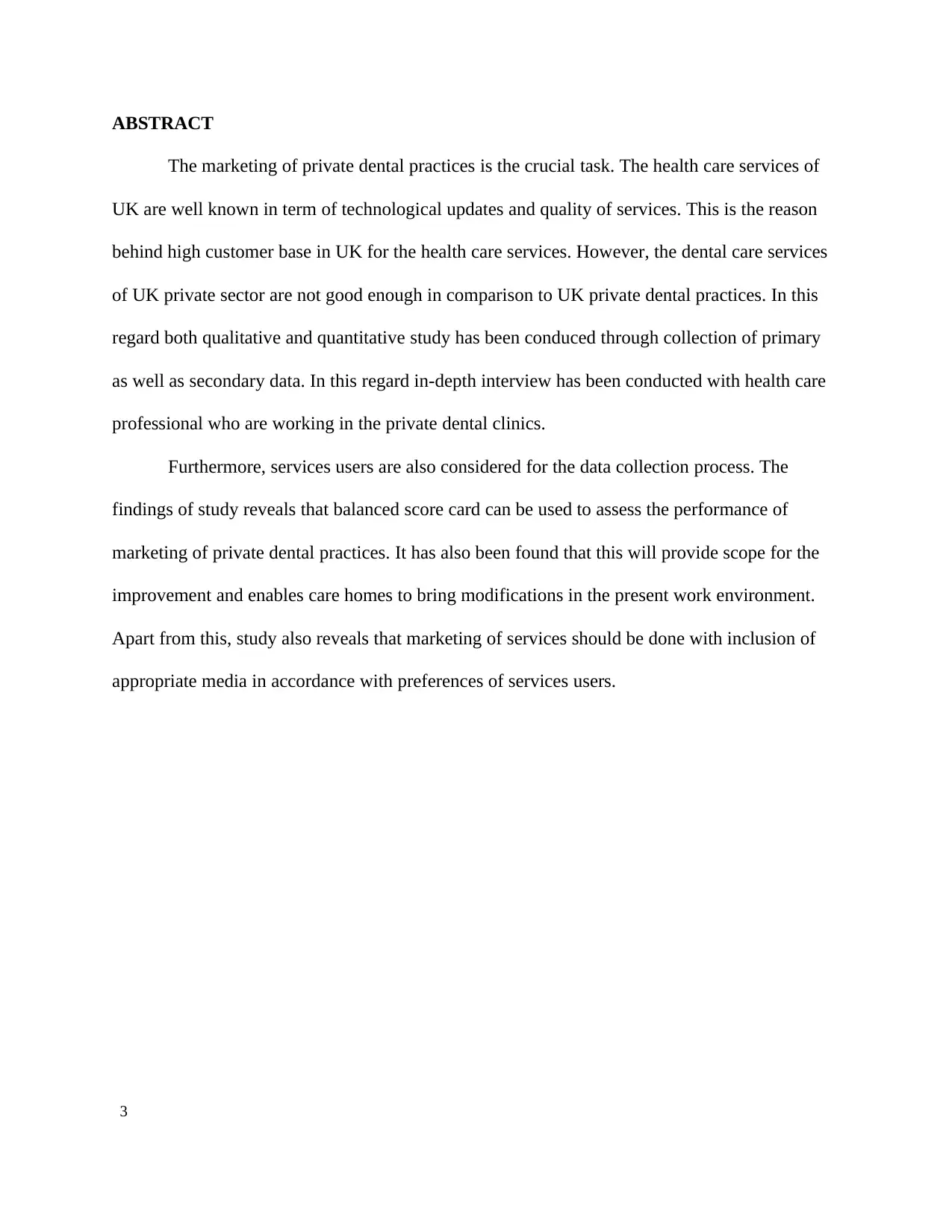
ABSTRACT
The marketing of private dental practices is the crucial task. The health care services of
UK are well known in term of technological updates and quality of services. This is the reason
behind high customer base in UK for the health care services. However, the dental care services
of UK private sector are not good enough in comparison to UK private dental practices. In this
regard both qualitative and quantitative study has been conduced through collection of primary
as well as secondary data. In this regard in-depth interview has been conducted with health care
professional who are working in the private dental clinics.
Furthermore, services users are also considered for the data collection process. The
findings of study reveals that balanced score card can be used to assess the performance of
marketing of private dental practices. It has also been found that this will provide scope for the
improvement and enables care homes to bring modifications in the present work environment.
Apart from this, study also reveals that marketing of services should be done with inclusion of
appropriate media in accordance with preferences of services users.
3
The marketing of private dental practices is the crucial task. The health care services of
UK are well known in term of technological updates and quality of services. This is the reason
behind high customer base in UK for the health care services. However, the dental care services
of UK private sector are not good enough in comparison to UK private dental practices. In this
regard both qualitative and quantitative study has been conduced through collection of primary
as well as secondary data. In this regard in-depth interview has been conducted with health care
professional who are working in the private dental clinics.
Furthermore, services users are also considered for the data collection process. The
findings of study reveals that balanced score card can be used to assess the performance of
marketing of private dental practices. It has also been found that this will provide scope for the
improvement and enables care homes to bring modifications in the present work environment.
Apart from this, study also reveals that marketing of services should be done with inclusion of
appropriate media in accordance with preferences of services users.
3
⊘ This is a preview!⊘
Do you want full access?
Subscribe today to unlock all pages.

Trusted by 1+ million students worldwide
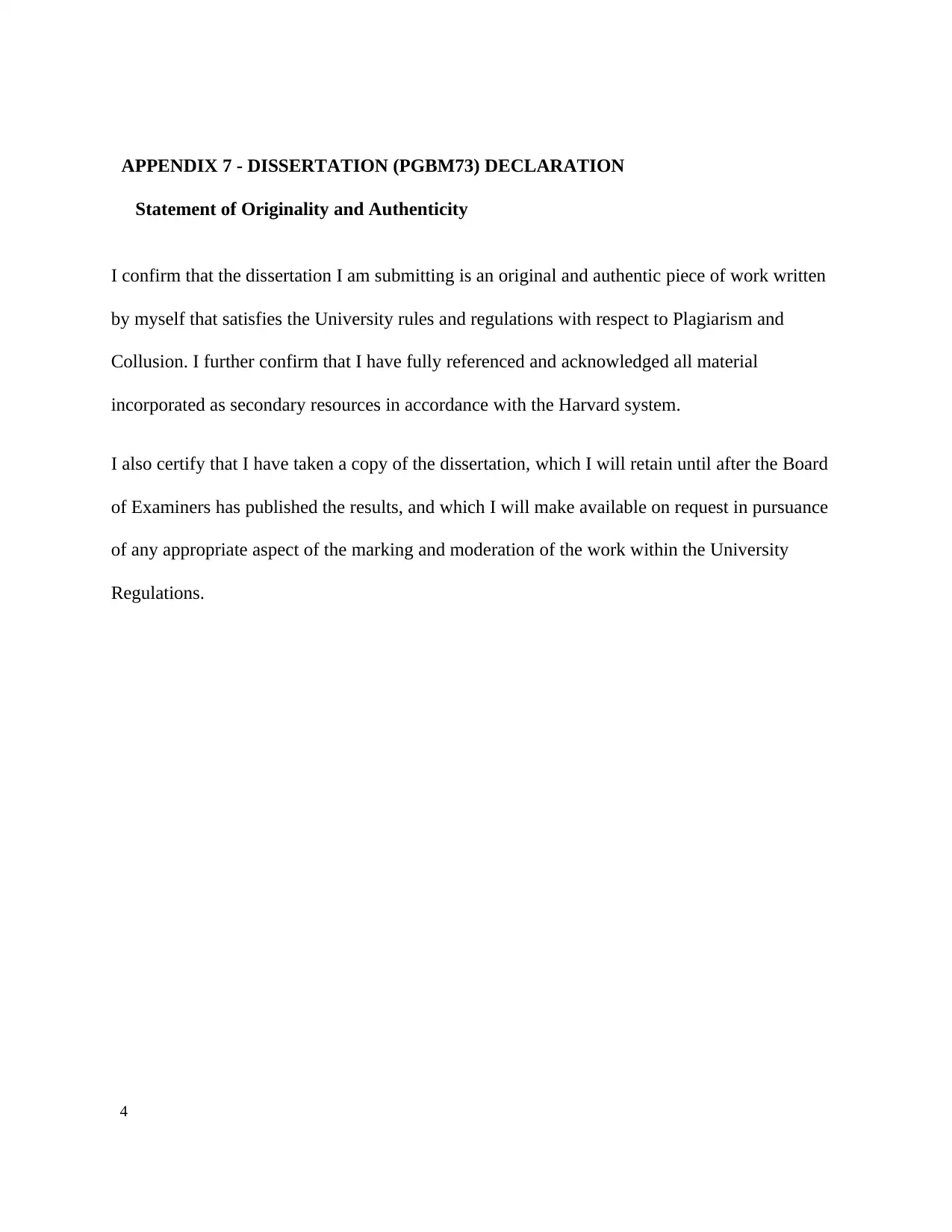
APPENDIX 7 - DISSERTATION (PGBM73) DECLARATION
Statement of Originality and Authenticity
I confirm that the dissertation I am submitting is an original and authentic piece of work written
by myself that satisfies the University rules and regulations with respect to Plagiarism and
Collusion. I further confirm that I have fully referenced and acknowledged all material
incorporated as secondary resources in accordance with the Harvard system.
I also certify that I have taken a copy of the dissertation, which I will retain until after the Board
of Examiners has published the results, and which I will make available on request in pursuance
of any appropriate aspect of the marking and moderation of the work within the University
Regulations.
4
Statement of Originality and Authenticity
I confirm that the dissertation I am submitting is an original and authentic piece of work written
by myself that satisfies the University rules and regulations with respect to Plagiarism and
Collusion. I further confirm that I have fully referenced and acknowledged all material
incorporated as secondary resources in accordance with the Harvard system.
I also certify that I have taken a copy of the dissertation, which I will retain until after the Board
of Examiners has published the results, and which I will make available on request in pursuance
of any appropriate aspect of the marking and moderation of the work within the University
Regulations.
4
Paraphrase This Document
Need a fresh take? Get an instant paraphrase of this document with our AI Paraphraser

Acknowledgements
First and foremost, I am grateful to my supervisor Thorben Haenel for his patience, dedicated
supervision and care. He is an expert in marketing which is highly related to the subject of this
thesis.
I would also like to show my appreciation to Professor Yahaya Alhassan who has been a
wonderful lecturer and inspiration.
I am grateful to my parents for their endless love and patience and support throughout all my
endeavours.
5
First and foremost, I am grateful to my supervisor Thorben Haenel for his patience, dedicated
supervision and care. He is an expert in marketing which is highly related to the subject of this
thesis.
I would also like to show my appreciation to Professor Yahaya Alhassan who has been a
wonderful lecturer and inspiration.
I am grateful to my parents for their endless love and patience and support throughout all my
endeavours.
5
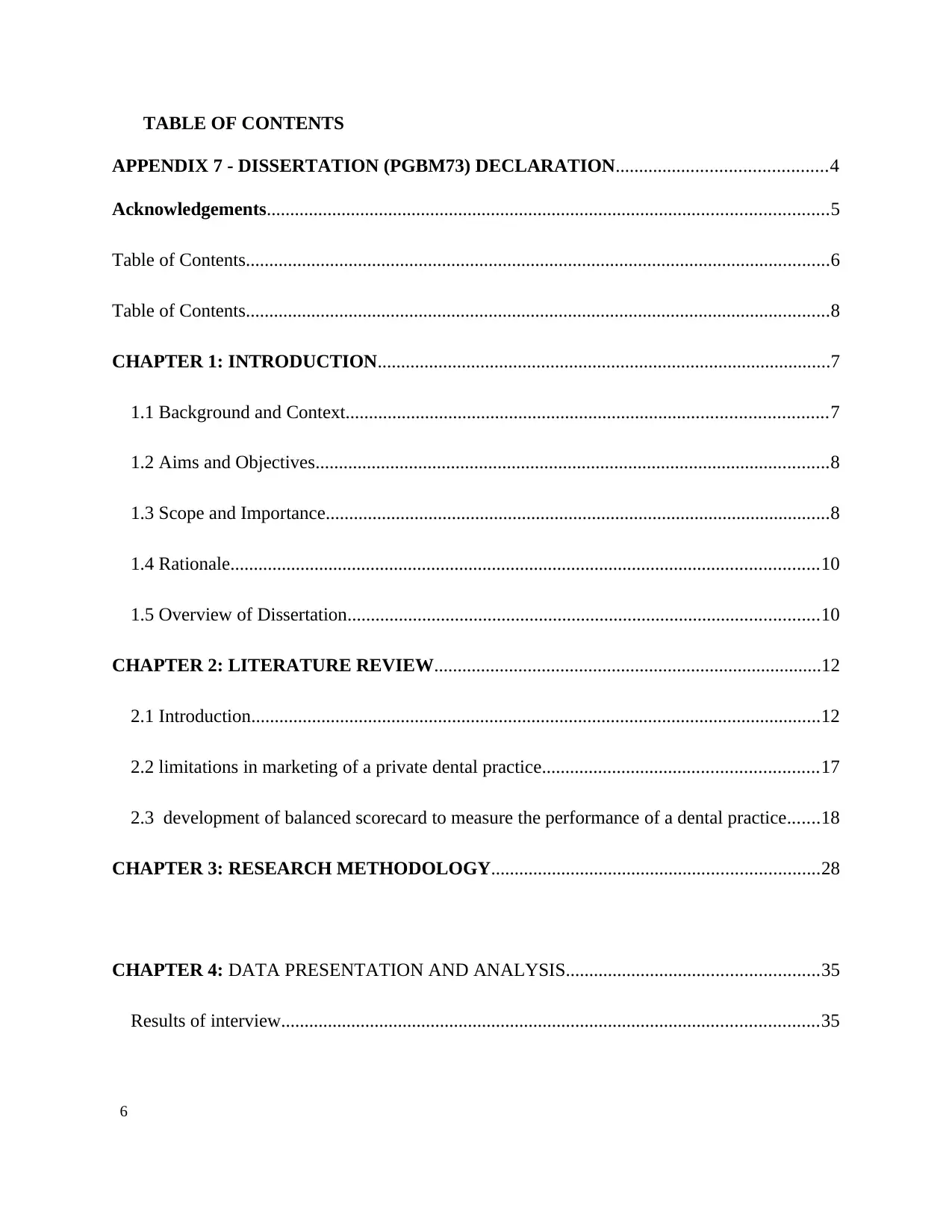
TABLE OF CONTENTS
APPENDIX 7 - DISSERTATION (PGBM73) DECLARATION.............................................4
Acknowledgements........................................................................................................................5
Table of Contents.............................................................................................................................6
Table of Contents.............................................................................................................................8
CHAPTER 1: INTRODUCTION.................................................................................................7
1.1 Background and Context.......................................................................................................7
1.2 Aims and Objectives..............................................................................................................8
1.3 Scope and Importance............................................................................................................8
1.4 Rationale..............................................................................................................................10
1.5 Overview of Dissertation.....................................................................................................10
CHAPTER 2: LITERATURE REVIEW...................................................................................12
2.1 Introduction..........................................................................................................................12
2.2 limitations in marketing of a private dental practice...........................................................17
2.3 development of balanced scorecard to measure the performance of a dental practice.......18
CHAPTER 3: RESEARCH METHODOLOGY......................................................................28
CHAPTER 4: DATA PRESENTATION AND ANALYSIS......................................................35
Results of interview...................................................................................................................35
6
APPENDIX 7 - DISSERTATION (PGBM73) DECLARATION.............................................4
Acknowledgements........................................................................................................................5
Table of Contents.............................................................................................................................6
Table of Contents.............................................................................................................................8
CHAPTER 1: INTRODUCTION.................................................................................................7
1.1 Background and Context.......................................................................................................7
1.2 Aims and Objectives..............................................................................................................8
1.3 Scope and Importance............................................................................................................8
1.4 Rationale..............................................................................................................................10
1.5 Overview of Dissertation.....................................................................................................10
CHAPTER 2: LITERATURE REVIEW...................................................................................12
2.1 Introduction..........................................................................................................................12
2.2 limitations in marketing of a private dental practice...........................................................17
2.3 development of balanced scorecard to measure the performance of a dental practice.......18
CHAPTER 3: RESEARCH METHODOLOGY......................................................................28
CHAPTER 4: DATA PRESENTATION AND ANALYSIS......................................................35
Results of interview...................................................................................................................35
6
⊘ This is a preview!⊘
Do you want full access?
Subscribe today to unlock all pages.

Trusted by 1+ million students worldwide
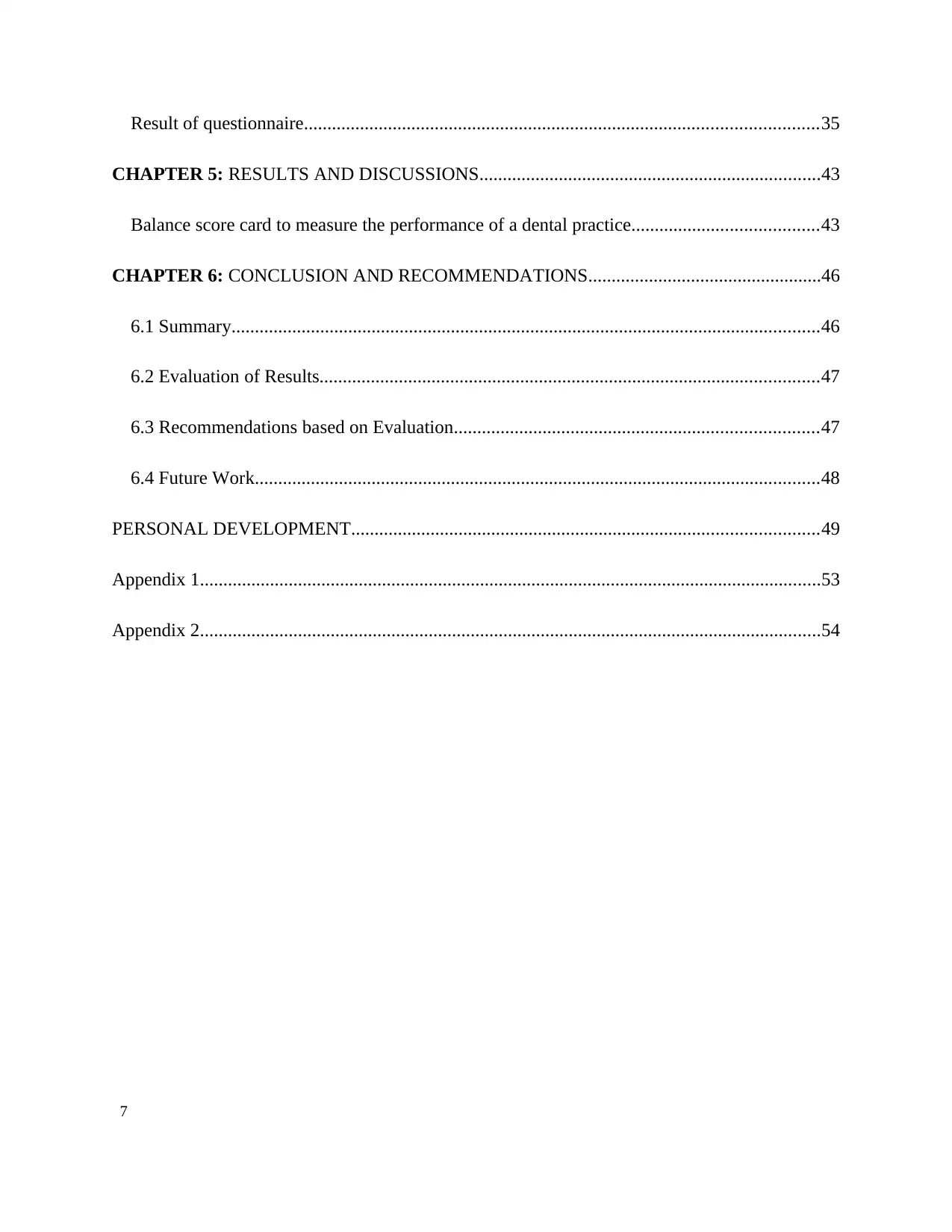
Result of questionnaire..............................................................................................................35
CHAPTER 5: RESULTS AND DISCUSSIONS.........................................................................43
Balance score card to measure the performance of a dental practice........................................43
CHAPTER 6: CONCLUSION AND RECOMMENDATIONS..................................................46
6.1 Summary..............................................................................................................................46
6.2 Evaluation of Results...........................................................................................................47
6.3 Recommendations based on Evaluation..............................................................................47
6.4 Future Work.........................................................................................................................48
PERSONAL DEVELOPMENT....................................................................................................49
Appendix 1.....................................................................................................................................53
Appendix 2.....................................................................................................................................54
7
CHAPTER 5: RESULTS AND DISCUSSIONS.........................................................................43
Balance score card to measure the performance of a dental practice........................................43
CHAPTER 6: CONCLUSION AND RECOMMENDATIONS..................................................46
6.1 Summary..............................................................................................................................46
6.2 Evaluation of Results...........................................................................................................47
6.3 Recommendations based on Evaluation..............................................................................47
6.4 Future Work.........................................................................................................................48
PERSONAL DEVELOPMENT....................................................................................................49
Appendix 1.....................................................................................................................................53
Appendix 2.....................................................................................................................................54
7
Paraphrase This Document
Need a fresh take? Get an instant paraphrase of this document with our AI Paraphraser
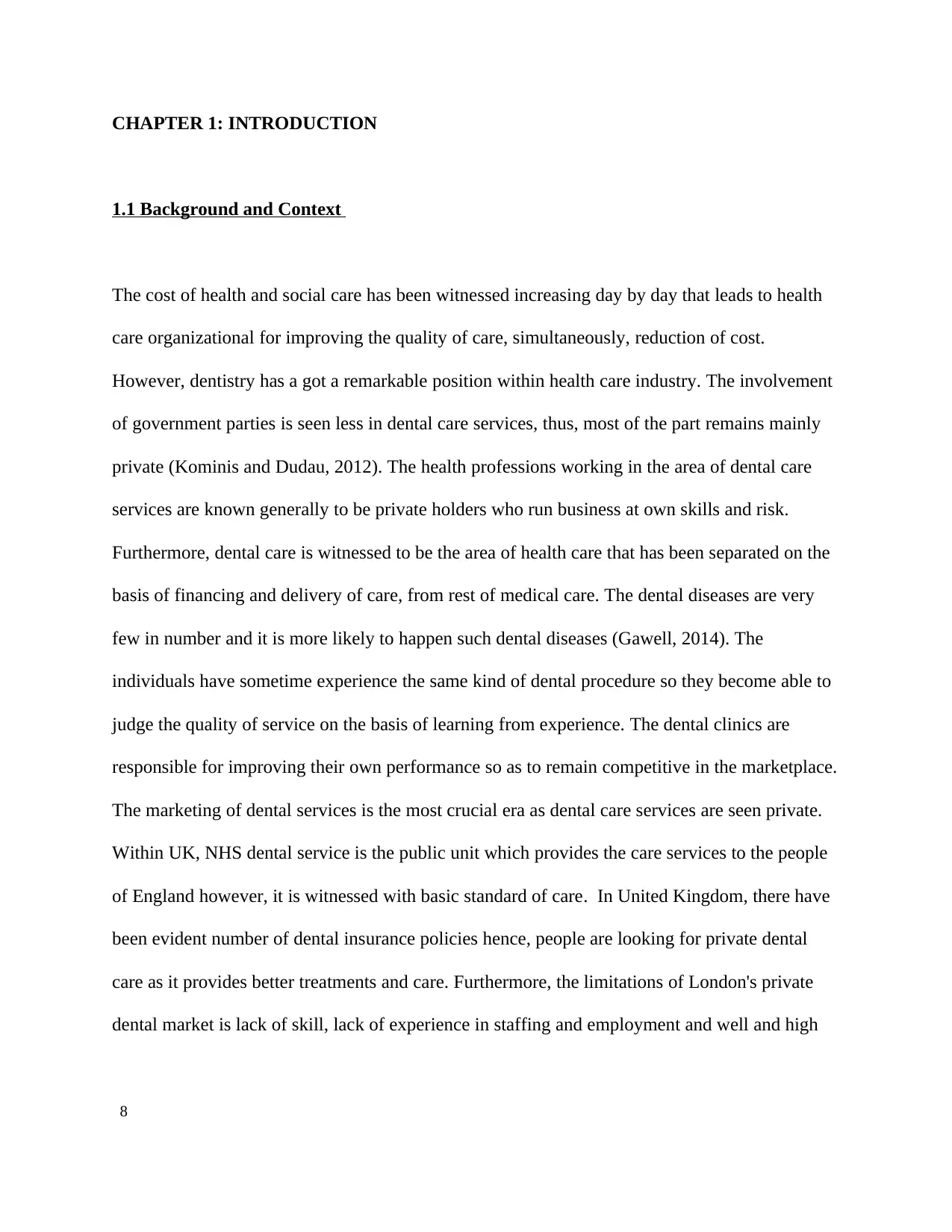
CHAPTER 1: INTRODUCTION
1.1 Background and Context
The cost of health and social care has been witnessed increasing day by day that leads to health
care organizational for improving the quality of care, simultaneously, reduction of cost.
However, dentistry has a got a remarkable position within health care industry. The involvement
of government parties is seen less in dental care services, thus, most of the part remains mainly
private (Kominis and Dudau, 2012). The health professions working in the area of dental care
services are known generally to be private holders who run business at own skills and risk.
Furthermore, dental care is witnessed to be the area of health care that has been separated on the
basis of financing and delivery of care, from rest of medical care. The dental diseases are very
few in number and it is more likely to happen such dental diseases (Gawell, 2014). The
individuals have sometime experience the same kind of dental procedure so they become able to
judge the quality of service on the basis of learning from experience. The dental clinics are
responsible for improving their own performance so as to remain competitive in the marketplace.
The marketing of dental services is the most crucial era as dental care services are seen private.
Within UK, NHS dental service is the public unit which provides the care services to the people
of England however, it is witnessed with basic standard of care. In United Kingdom, there have
been evident number of dental insurance policies hence, people are looking for private dental
care as it provides better treatments and care. Furthermore, the limitations of London's private
dental market is lack of skill, lack of experience in staffing and employment and well and high
8
1.1 Background and Context
The cost of health and social care has been witnessed increasing day by day that leads to health
care organizational for improving the quality of care, simultaneously, reduction of cost.
However, dentistry has a got a remarkable position within health care industry. The involvement
of government parties is seen less in dental care services, thus, most of the part remains mainly
private (Kominis and Dudau, 2012). The health professions working in the area of dental care
services are known generally to be private holders who run business at own skills and risk.
Furthermore, dental care is witnessed to be the area of health care that has been separated on the
basis of financing and delivery of care, from rest of medical care. The dental diseases are very
few in number and it is more likely to happen such dental diseases (Gawell, 2014). The
individuals have sometime experience the same kind of dental procedure so they become able to
judge the quality of service on the basis of learning from experience. The dental clinics are
responsible for improving their own performance so as to remain competitive in the marketplace.
The marketing of dental services is the most crucial era as dental care services are seen private.
Within UK, NHS dental service is the public unit which provides the care services to the people
of England however, it is witnessed with basic standard of care. In United Kingdom, there have
been evident number of dental insurance policies hence, people are looking for private dental
care as it provides better treatments and care. Furthermore, the limitations of London's private
dental market is lack of skill, lack of experience in staffing and employment and well and high
8
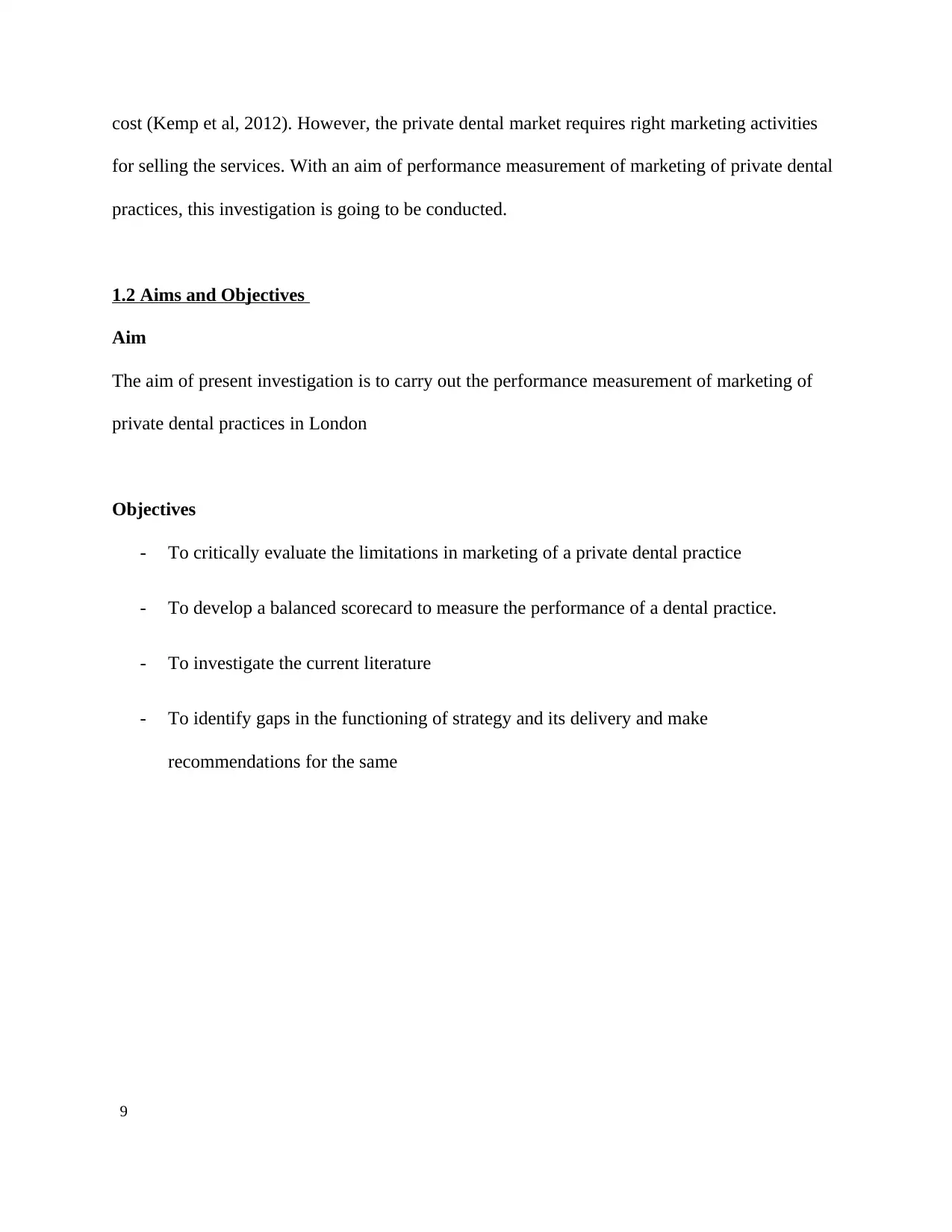
cost (Kemp et al, 2012). However, the private dental market requires right marketing activities
for selling the services. With an aim of performance measurement of marketing of private dental
practices, this investigation is going to be conducted.
1.2 Aims and Objectives
Aim
The aim of present investigation is to carry out the performance measurement of marketing of
private dental practices in London
Objectives
- To critically evaluate the limitations in marketing of a private dental practice
- To develop a balanced scorecard to measure the performance of a dental practice.
- To investigate the current literature
- To identify gaps in the functioning of strategy and its delivery and make
recommendations for the same
9
for selling the services. With an aim of performance measurement of marketing of private dental
practices, this investigation is going to be conducted.
1.2 Aims and Objectives
Aim
The aim of present investigation is to carry out the performance measurement of marketing of
private dental practices in London
Objectives
- To critically evaluate the limitations in marketing of a private dental practice
- To develop a balanced scorecard to measure the performance of a dental practice.
- To investigate the current literature
- To identify gaps in the functioning of strategy and its delivery and make
recommendations for the same
9
⊘ This is a preview!⊘
Do you want full access?
Subscribe today to unlock all pages.

Trusted by 1+ million students worldwide
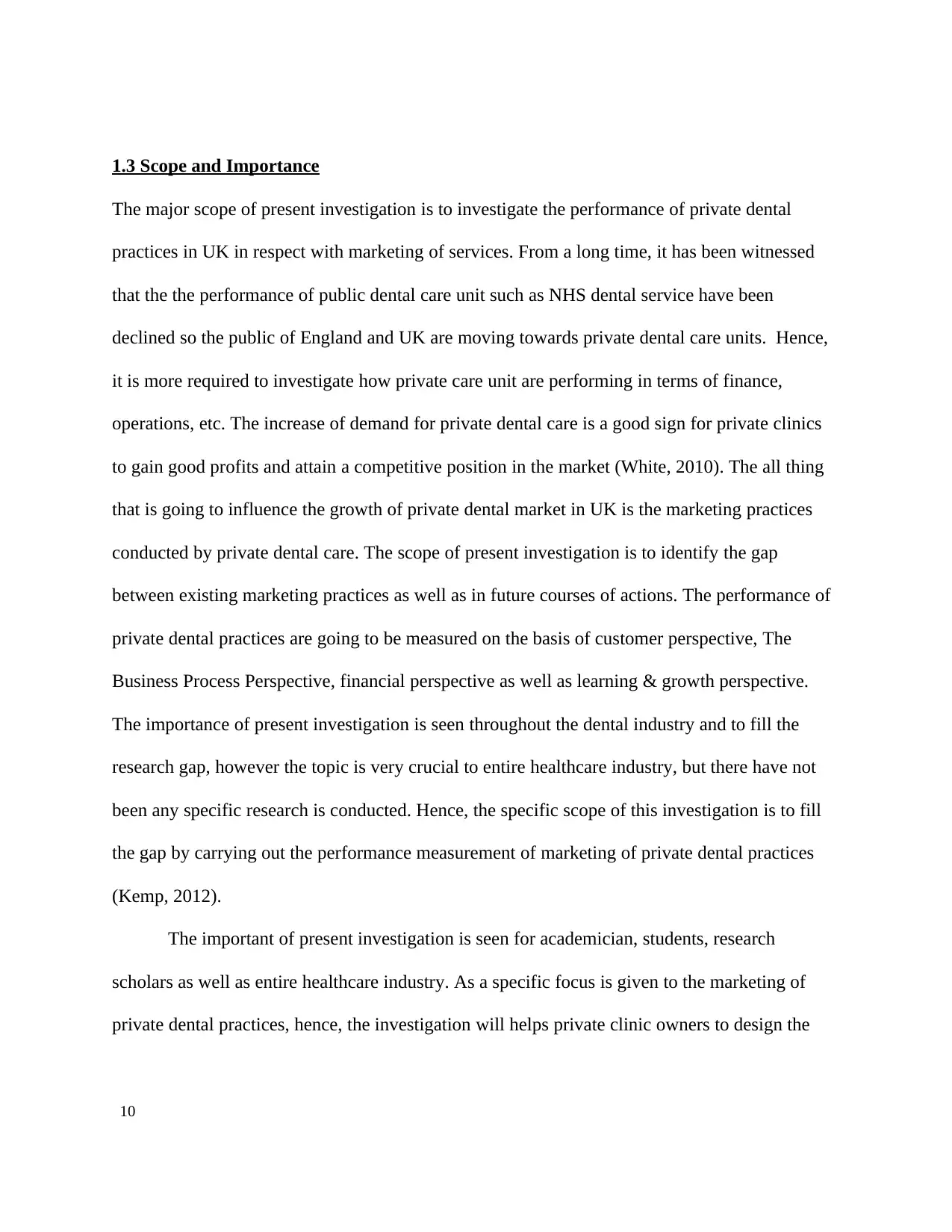
1.3 Scope and Importance
The major scope of present investigation is to investigate the performance of private dental
practices in UK in respect with marketing of services. From a long time, it has been witnessed
that the the performance of public dental care unit such as NHS dental service have been
declined so the public of England and UK are moving towards private dental care units. Hence,
it is more required to investigate how private care unit are performing in terms of finance,
operations, etc. The increase of demand for private dental care is a good sign for private clinics
to gain good profits and attain a competitive position in the market (White, 2010). The all thing
that is going to influence the growth of private dental market in UK is the marketing practices
conducted by private dental care. The scope of present investigation is to identify the gap
between existing marketing practices as well as in future courses of actions. The performance of
private dental practices are going to be measured on the basis of customer perspective, The
Business Process Perspective, financial perspective as well as learning & growth perspective.
The importance of present investigation is seen throughout the dental industry and to fill the
research gap, however the topic is very crucial to entire healthcare industry, but there have not
been any specific research is conducted. Hence, the specific scope of this investigation is to fill
the gap by carrying out the performance measurement of marketing of private dental practices
(Kemp, 2012).
The important of present investigation is seen for academician, students, research
scholars as well as entire healthcare industry. As a specific focus is given to the marketing of
private dental practices, hence, the investigation will helps private clinic owners to design the
10
The major scope of present investigation is to investigate the performance of private dental
practices in UK in respect with marketing of services. From a long time, it has been witnessed
that the the performance of public dental care unit such as NHS dental service have been
declined so the public of England and UK are moving towards private dental care units. Hence,
it is more required to investigate how private care unit are performing in terms of finance,
operations, etc. The increase of demand for private dental care is a good sign for private clinics
to gain good profits and attain a competitive position in the market (White, 2010). The all thing
that is going to influence the growth of private dental market in UK is the marketing practices
conducted by private dental care. The scope of present investigation is to identify the gap
between existing marketing practices as well as in future courses of actions. The performance of
private dental practices are going to be measured on the basis of customer perspective, The
Business Process Perspective, financial perspective as well as learning & growth perspective.
The importance of present investigation is seen throughout the dental industry and to fill the
research gap, however the topic is very crucial to entire healthcare industry, but there have not
been any specific research is conducted. Hence, the specific scope of this investigation is to fill
the gap by carrying out the performance measurement of marketing of private dental practices
(Kemp, 2012).
The important of present investigation is seen for academician, students, research
scholars as well as entire healthcare industry. As a specific focus is given to the marketing of
private dental practices, hence, the investigation will helps private clinic owners to design the
10
Paraphrase This Document
Need a fresh take? Get an instant paraphrase of this document with our AI Paraphraser
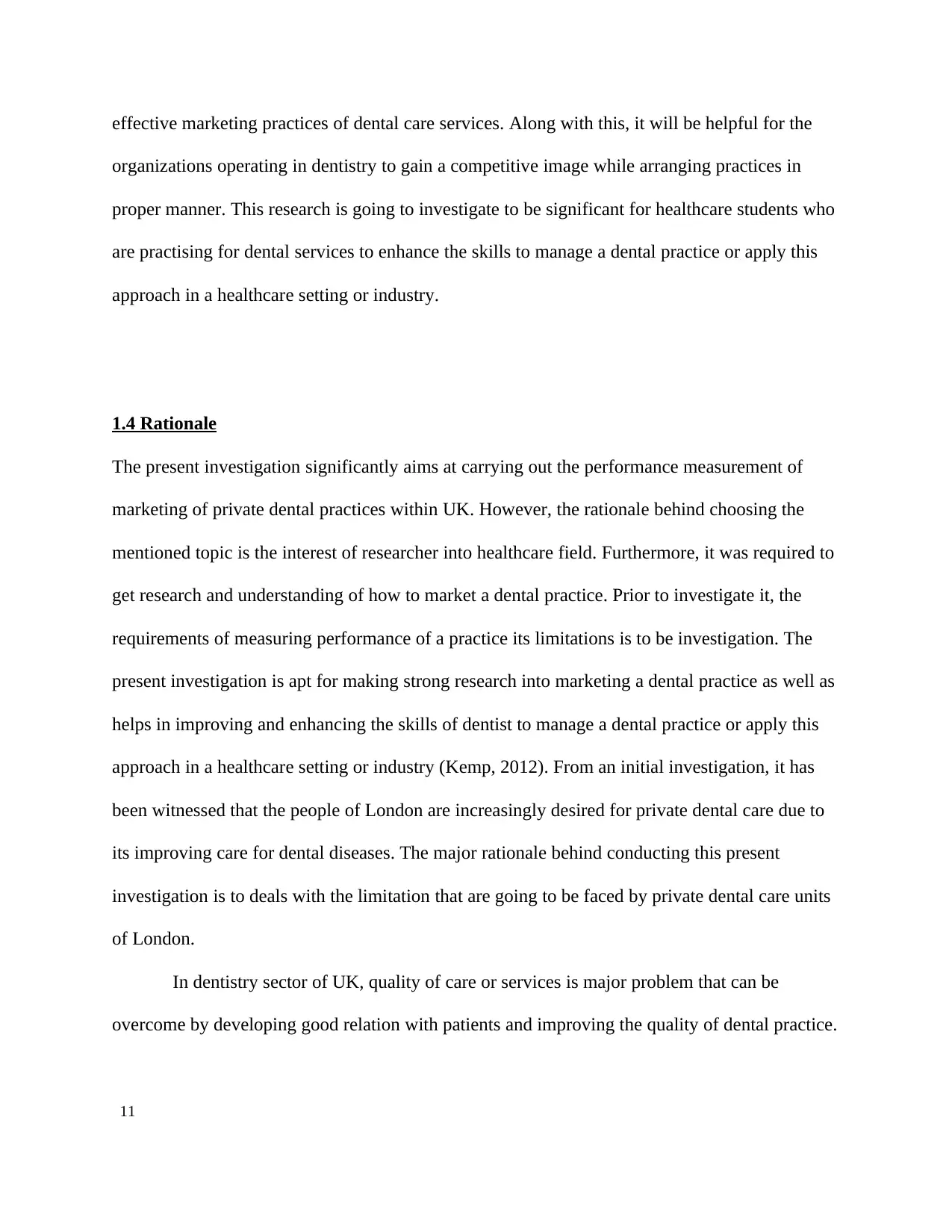
effective marketing practices of dental care services. Along with this, it will be helpful for the
organizations operating in dentistry to gain a competitive image while arranging practices in
proper manner. This research is going to investigate to be significant for healthcare students who
are practising for dental services to enhance the skills to manage a dental practice or apply this
approach in a healthcare setting or industry.
1.4 Rationale
The present investigation significantly aims at carrying out the performance measurement of
marketing of private dental practices within UK. However, the rationale behind choosing the
mentioned topic is the interest of researcher into healthcare field. Furthermore, it was required to
get research and understanding of how to market a dental practice. Prior to investigate it, the
requirements of measuring performance of a practice its limitations is to be investigation. The
present investigation is apt for making strong research into marketing a dental practice as well as
helps in improving and enhancing the skills of dentist to manage a dental practice or apply this
approach in a healthcare setting or industry (Kemp, 2012). From an initial investigation, it has
been witnessed that the people of London are increasingly desired for private dental care due to
its improving care for dental diseases. The major rationale behind conducting this present
investigation is to deals with the limitation that are going to be faced by private dental care units
of London.
In dentistry sector of UK, quality of care or services is major problem that can be
overcome by developing good relation with patients and improving the quality of dental practice.
11
organizations operating in dentistry to gain a competitive image while arranging practices in
proper manner. This research is going to investigate to be significant for healthcare students who
are practising for dental services to enhance the skills to manage a dental practice or apply this
approach in a healthcare setting or industry.
1.4 Rationale
The present investigation significantly aims at carrying out the performance measurement of
marketing of private dental practices within UK. However, the rationale behind choosing the
mentioned topic is the interest of researcher into healthcare field. Furthermore, it was required to
get research and understanding of how to market a dental practice. Prior to investigate it, the
requirements of measuring performance of a practice its limitations is to be investigation. The
present investigation is apt for making strong research into marketing a dental practice as well as
helps in improving and enhancing the skills of dentist to manage a dental practice or apply this
approach in a healthcare setting or industry (Kemp, 2012). From an initial investigation, it has
been witnessed that the people of London are increasingly desired for private dental care due to
its improving care for dental diseases. The major rationale behind conducting this present
investigation is to deals with the limitation that are going to be faced by private dental care units
of London.
In dentistry sector of UK, quality of care or services is major problem that can be
overcome by developing good relation with patients and improving the quality of dental practice.
11
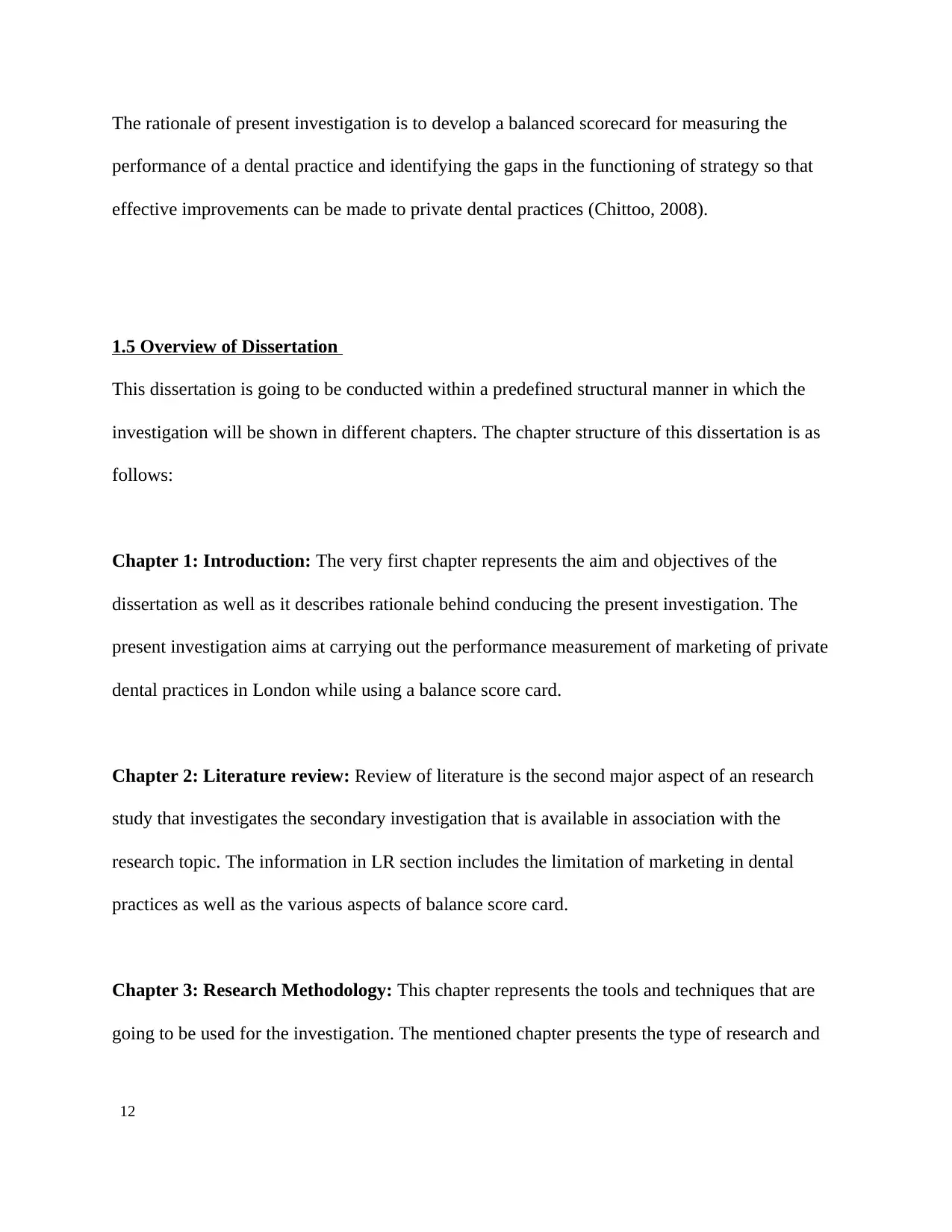
The rationale of present investigation is to develop a balanced scorecard for measuring the
performance of a dental practice and identifying the gaps in the functioning of strategy so that
effective improvements can be made to private dental practices (Chittoo, 2008).
1.5 Overview of Dissertation
This dissertation is going to be conducted within a predefined structural manner in which the
investigation will be shown in different chapters. The chapter structure of this dissertation is as
follows:
Chapter 1: Introduction: The very first chapter represents the aim and objectives of the
dissertation as well as it describes rationale behind conducing the present investigation. The
present investigation aims at carrying out the performance measurement of marketing of private
dental practices in London while using a balance score card.
Chapter 2: Literature review: Review of literature is the second major aspect of an research
study that investigates the secondary investigation that is available in association with the
research topic. The information in LR section includes the limitation of marketing in dental
practices as well as the various aspects of balance score card.
Chapter 3: Research Methodology: This chapter represents the tools and techniques that are
going to be used for the investigation. The mentioned chapter presents the type of research and
12
performance of a dental practice and identifying the gaps in the functioning of strategy so that
effective improvements can be made to private dental practices (Chittoo, 2008).
1.5 Overview of Dissertation
This dissertation is going to be conducted within a predefined structural manner in which the
investigation will be shown in different chapters. The chapter structure of this dissertation is as
follows:
Chapter 1: Introduction: The very first chapter represents the aim and objectives of the
dissertation as well as it describes rationale behind conducing the present investigation. The
present investigation aims at carrying out the performance measurement of marketing of private
dental practices in London while using a balance score card.
Chapter 2: Literature review: Review of literature is the second major aspect of an research
study that investigates the secondary investigation that is available in association with the
research topic. The information in LR section includes the limitation of marketing in dental
practices as well as the various aspects of balance score card.
Chapter 3: Research Methodology: This chapter represents the tools and techniques that are
going to be used for the investigation. The mentioned chapter presents the type of research and
12
⊘ This is a preview!⊘
Do you want full access?
Subscribe today to unlock all pages.

Trusted by 1+ million students worldwide
1 out of 122
Related Documents
Your All-in-One AI-Powered Toolkit for Academic Success.
+13062052269
info@desklib.com
Available 24*7 on WhatsApp / Email
![[object Object]](/_next/static/media/star-bottom.7253800d.svg)
Unlock your academic potential
Copyright © 2020–2025 A2Z Services. All Rights Reserved. Developed and managed by ZUCOL.





